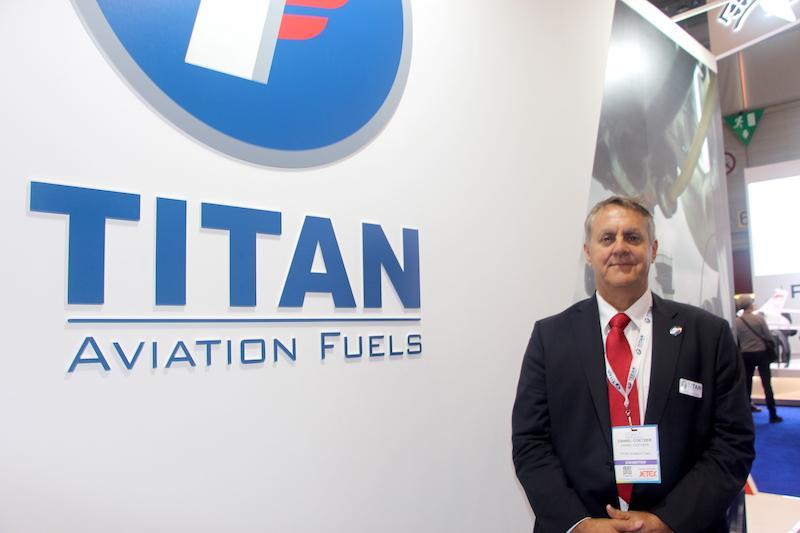
GENEVA—EBACE has been hearing a lot about sustainable aviation fuels (SAF), the challenges of increasing the rate at which they are being bought, and the critical importance the technology will play in the sector's efforts to achieve its carbon-reduction targets.
Aircraft manufacturers, operators, owners and users are all committed to increasing the adoption of SAF, and overcoming problems around pricing. But five minutes of conversation with Daniel Coetzer, the CEO of Titan Aviation Fuels' new EMEA operation, reveals a host of other complications that the industry will have to overcome before SAF can become mainstream.
"The product is not available," he says. "Where we can buy SAF from suppliers, we buy it and we supply it. We would love to find [a supplier] that can supply us SAF on a permanent basis that we can have somewhere. We really need it. We would like to sell it more—and at a more competitive price to Jet A1. But it's difficult. There's just not enough product on the market."
Coetzer spent nearly a decade running Colt International Europe before founding Valcora in Geneva in 2016, and then fuel provider AKRYL in 2021.
U.S.-focused Titan acquired AKRYL earlier this year to access the European market and to get AKRYL's digital platform which is designed to make it simpler for customers to order and pay for their fuel. Coetzer, who stayed on after the merger to head up the new European business, has therefore observed the SAF story from a perspective that is subtly but significantly different than that of a fuel producer or consumer.
The reasons behind the dearth of supply to smaller users are complex, and not the ones which an audience familiar with business-aviation's efforts to prioritize SAF uptake may might expect to hear. Some larger players can cut big deals with SAF refineries, essentially acquiring all a facility's output. And despite the higher price, adoption by commercial airlines is strong. Their higher and more regularized utilization requirements put them in a better place to make large orders than bizav users will ever be.
"People pre-buy the product," Coetzer says. "If you go to Neste and say 'I want supply,' they'll tell you: 'We can supply you in 2024.' There's just not enough for the demand. The airlines like it, and they are more the beneficiaries of it, because they have more passengers that pay towards it."
Business aviation has a track record of leading change in the aerospace sector, and senior industry figures have suggested or implied that the sector's end users ought to find it easier to absorb the extra cost of using SAF than might be the case for a commercial airline, where even a small price increase per seat will send significant numbers of customers to cheaper competitors. Bizav, the logic ran, would be faster to adopt SAF than the commercial airline sector. The reality, Coetzer's experience suggests, has turned out to be rather different.
"When SAF really started to get on the market in very limited amounts, yes, everybody had the thought that it would be ideal for business aviation; it can make business aviation really clean, and give it a very good image," he says. "But when the big-volume airlines arrived, they just gobbled it up. And you can't really blame the SAF producers if they can sell all their product in one shot rather than sell it little by little to business aviation."
Business aviation's versatility and adaptability may also be working against its efforts to promote SAF usage, he suggests.
"Business aviation is quite spread out," he says. "Business aviation movements are not as predictable, standard and set. In the airline business, they know they're flying from Geneva to Paris twice a day, so it's easier to say, 'We'll have SAF at this location.' I know of some companies who put SAF in some [business-aviation] airports, and after three months it had not sold."
Squaring this circle will be challenging, he says, because so few feedstocks are available in sufficient quantities to increase SAF production significantly.
"We're jumping the gun on it," he says. "We're saying we're going to have so many million gallons by a particular time—but, sorry, we're not going to make all that from cooking oil. SAF became an industry overnight. It's building up, but they don't have all the answers yet."
Another potential avenue to aid adoption—the use of book-and-claim accounting processes, where SAF is paid for in one location where it is not available and the corresponding amount of fuel is put into an aircraft elsewhere, with the buyer receiving the emissions-reduction credit—may be a viable alternative in the U.S., but not everywhere else.
"It just doesn't work in Europe," Coetzer says. "There are so many different taxation regimes. You're supposed to have one taxation scheme, but it's not: every country has a little bit of its own in there as well. And then you have Switzerland, Turkey and the other countries. And the UK."
In the mean time, Titan offers a comprehensive and carefully vetted selection of offsetting options. This solution remain controversial, but for the time being, it offers some compelling advantages. "It's more clean, it's more clear, and everybody understands it," he says. It is also available everywhere, right now.

